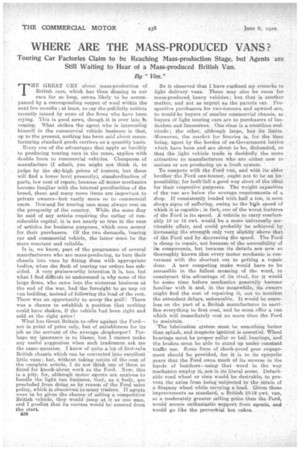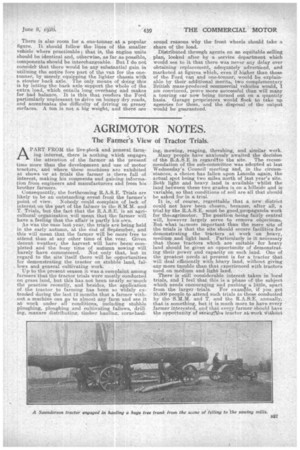• WHERE ARE THE MASS-PRODUCED VANS?
Page 22

Page 23

If you've noticed an error in this article please click here to report it so we can fix it.
Touring Car Factories Claim to be Reaching Mass-production Stage, but Agents are Still Waiting to Hear of a Mass-produced British Van.
By .14 Vim :3
THE GREAT CRY about mass-production of. British ears, which has been dinning in our ears for so long, seems likely to be accompanied by a corresponding output of wool within the next few months ; at least, so say the publicity notices recently issued by some of the firms who have been crying. This is good news, though it is over late fn. coming. What strikes the agent who is interesting himself in the commercial vehicle business is that, up to the present, nothing has been said about manufacturing standard goads carriers on a, quantity basis.
Every one of the advantages that apply so forcibly to producing touring cars in the mass, applies with double fore to commercial vehicles. Cheapness of manufacture (I admit, you might not think it, to judge by the sky-high prices of tourers, but these will find a lower level presently), standardization of parts, low cost of repair, because all motor mechanics become familiar with the internal peculiarities of the breed, these, and many more items are important to private owners—but vastly more so to conimereial users. Dema.nd for touring cars must always rest on the prosperity of the country. While the same thhay be said of any article requiring the outlay of considerable Capital, it is not nearly so true in the case of articles for business purposes, which earn money for their purchasers. Of the two demands, touring car and commercial vehicle, the latter must be the more constant and reliable. ,
It is, we know, part of the programme of several manufacturers who are mass-producing, to turn their elia_ssis into vans by fitting them with appropriate bodies, when the flush of touring car orders has subsided. A very praiseworthy intention it is, too, but what I find difficult to understand is why none of the large firms, who came into the motorcar business at the end of the war, had the foresight to go. nap on van building, instead of following the lead of the rest. There was an opportunity to scoop-the pool! There was a chance to establish a position that nothing could have shaken, if the vehicle bad been right and sold at the right price!
What has Great Britain to offer against the Ford— not. in point of price only, but of suitableness for its job as the servant of the average shopkeeper? Perhaps my ignorance is to blame, but I cannot make any useful suggestion when such tradesmen ask me the same question. I know of quite a lot of first-rate British chassis which can be converted into excellent little vans; but, Without taking notice of the cost of the eomplete article, I do not think one of them so fitted for knock-about work as the Ford. Now, this is a pity, for, although motor agents are anxious to handle the light van business, they, as a .body, are precluded.from doing so by reason of the 'Ford sales policy, which is obnoxious to many traders. If agents _ were to he given the chance of selling a competitive British 'vehicle, they would jump at it. as one man, and I predict that its success would he assured from the start.
B36 Be it observed that I have CQDfined my remarks to light delivery vans. There may -also be room for mass-produced, heavy vehicles; but that is another
matter, and not as urgent as. the parcels .car. Prospective purchasers for two-tonners and upward -are,
to would-be buyers of smaller commercial chassis, as buyers of light touring cars are to purchasers of Ianciaulets and limousines. One class is a countless mul titude ; the other, although large, has its limits. -Moreover, the market for &amines is, for the time being, upset by the hordes of ex-Govenunent lorrieswhich have been and are about to be, disbanded, so that the light vehicle trade is decidedly. the more attractive to manufacturers who are either new to motors or are producing on a fresh 'system.
To compete with the Ford vari, and with its elder brother the Ford" one-tonner, ought not to be an im possibility, for both'fall a good way short of the ideal for their respective purposes. The weight capacities of the van are below the average requirements of a shop. If consistently loaded with-hall a ton, it soon shots signs of suffering, owing to the high speed of which it is capable; in fact, one of the worst features of the Ferd is its speed. A vehicle to carry comfort ably 10 or 12 cwt. would, be a more Universally serviceable affair, and could probably be achieved by increasing the strength only very slightly above that of the Ford and by decreasing the speed. The Ford is cheap to repair, not because of the accessibility of its components, but because its details are now so thoroughly known that every motor mechanic is conversant with the shortest cut to getting a repair done. A new competing make would have to be accessible in the fullest meaning of the word, to • counteract this advantage of its rival, for it would be some time before mechanics generally bechome familiar with it and, in the meanwhile, its owners might find the cost of repairing it, not to mention the attendant delays, unbearable. It would he sense
less on the part of a British manufacturer to sacrifice everything to first cost, and he must offer a, van which will immediately east DO more than the Ford to maintain.
The lubrication system must be something better than splash, and magneto ignition is essential. Wheel bearings must, be proper roller or ball bearings, and the brakes must be able to stand up under constant traffic use. Some form of shock-proof gear engage ment should be provided, for it is to, its epicyclie
gears that the Ford owes much of its-success in. the hands of butehers—using that ward in the way
anachanics employ it not in its literal sense. Detachable road wheel or rittis would be desirable, to prevent the .axlesfrom being' subjectedto 'the strain of a Stepney wheel while carrying a load. Given these improvements as standard, a -British 10-12 .cwt. van, ata moderately greater selling price than the Ford, would secure enthusiastic 'support froin agents, and would go like the proverbial hot cakes.
There is also room. for a one-tonuer at a popular figure. It should follow the lines of the smaller vehicle where practicable; that is, the engine units should be identical and, otherwise, as far as possible, components should be interchangeable. But I do not consideithat there would be any substantial gain in utilizing the entire fore part of the van for the oneteener, by merely. equipping the lighter chassis with a stouter back axle. The only means of doing this is by letting the back axle support the whole of the extra load, which entails long overhang and makes for bad balance. It is this that renders the Ford particularly unpleasant to drive on bumpy dry roads, and accentuates the difficulty of driving on greasy surfaces. A ton is not a big weight, and there are sound reasons why thefront wheels should take a share of the load.
Distributed through agents on an equitable selling plan, looked after by a service department which would see to it that there was never any delay over obtaining replacement, adequately advertised, and marketed at figures which, even if higher than those of the Ford van' and one-tonner' would be explainable by their additional merits, two complementary British mass-produced commercial vehicles would, I am convinced, prove more successful than will many a touring car now being turned oat on a quantity basis. 011arage proprietors would flock to take up agencies for them and the disposal of the output would be guaranteed.




























